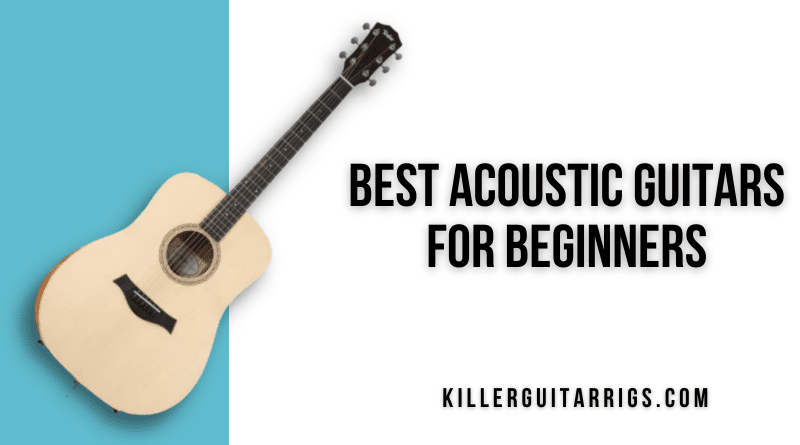Not too long ago, it was almost impossible to find a beginner or student-level acoustic guitar that sounded good or was in any way well-made or good-looking.
Fortunately, we’re now living in a golden age of guitar-making. CNC manufacturing processes have made it possible to significantly improve the consistency of quality in even the most basic budget models, and big-name brands even offer entire lines of entry-level guitars.
The big problem now is making a decision. There are so many beginner acoustic guitars to choose from, how do you know which is best? In this KillerGuitarRigs Review, we’ll be looking at the 7 Best Acoustic Guitars for Beginners. In doing so, we’ll cover a range of prices to suit all budgets, and we’ll otherwise be focusing on features, sound, and overall build quality.
Read more about our review process.
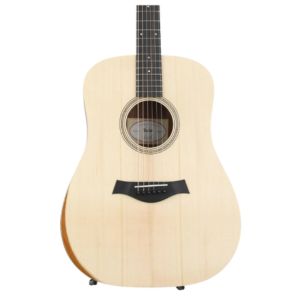
Taylor Academy 10
Features: Carved armrest, Sitka spruce top, Ebony fretboard
Benefits: Sparkly tones, Extremely comfortable, Huge sustain
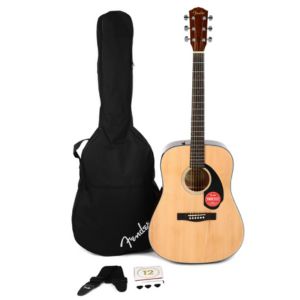
Fender CD-60S
Features: Includes gig bag, Solid spruce top, Low action
Benefits: Great playability, Sparkling top end, Booming voice
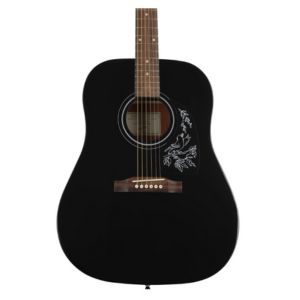
Epiphone Starling
Features: Spruce/mahogany construction, Slim neck, Dreadnought body style
Benefits: Rich tones, Handsome looks, Excellent beginner playability
Contents
Our Top 3
Our Top Pick was the Fender CD-60S. This is a wonderful beginner’s guitar from arguably the biggest brand name out there. It’s well-made, uses some great components including solid tone wood, and it will grow with a player as they progress.
Shoppers looking for a great guitar at a bargain price should check out our Best Budget option, the Epiphone Starling. Featuring similar styling to its close relative, the Epiphone Hummingbird, the starling packs great looks, great quality, and great tones into an incredibly affordable guitar.
If you’re not worried about price and you’re looking for the best beginner acoustic guitar, bar none, take a look at our Editor’s Choice, the Taylor Academy 10. As you can probably guess from the name, the Academy 10 is from Taylor’s student series, but that doesn’t make it any less of a Taylor. It sounds incredible and offers the best playability you’ll find on any beginner-focused guitar.
Individual Reviews
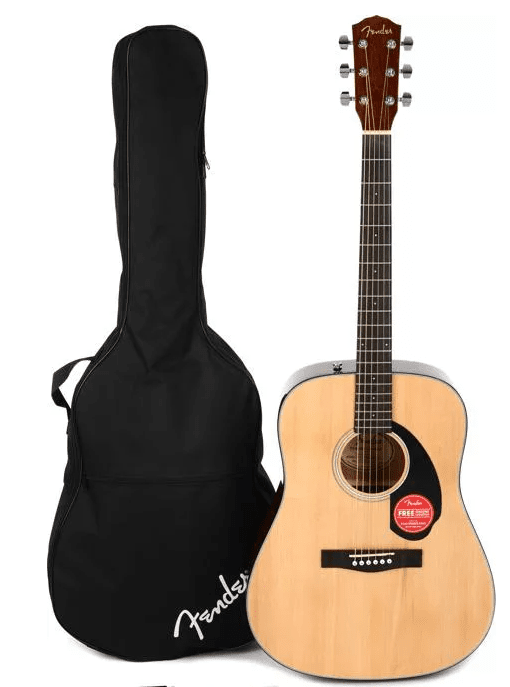
Fender CD-60S
A great looking guitar with excellent playability and solid tone woods.
Players looking for a handsome, well made acoustic from a big name brand will absolutely love this Fender dreadnought. It has the big booming tones you’d expect, but keeps playability beginner friendly with a comfortable neck profile and well finished frets.
We absolutely loved that the Fender CD-60S was actually Fender branded (full review here). Across their electric guitar line, getting the Fender name on the headstock means spending $800 or more if you plan to buy new, so to find that this model is a bona-fide Fender at such a low price makes it all the more appealing.
This model is available in 2 finishes, black, or natural. We received the natural model to test, and we really did love the overall appearance. The solid spruce top had a nice grain and wasn’t too pale. There was attractive multi-ply binding between the top and the laminated mahogany back and sides, which made this look like a much more expensive guitar than it really is.
The neck was slim and comfortable, and being solid mahogany, added some warmth to the tone. The neck shape is Fender’s “Easy to Play” profile, a design especially made for beginners to experience maximum comfort while playing. We really found it made a positive difference to how long we wanted to keep playing this guitar.
It featured a walnut fretboard, which made a nice change from the Indian laurel normally found at this price point. It looked nice and didn’t feel at all dry. Another great feature that’s almost never found in beginner instruments was the rolled fretboard. Instead of leaving the corners with defined angles, Fender has rounded them off, further increasing the comfort and playability of the excellent neck.
After spending some time playing it, we found that it offered a great tonal balance, with plenty of big bottom end, just like you’d expect from a full-size dreadnought. When strummed hard, this is a loud guitar, but soften the attack and you’re rewarded with a much gentler response. Despite the prominent bass response, we still found it to be bright and, especially with new strings, incredibly shimmery.
It held tune very well, and that’s in large part due to the excellent stock tuners. Like many of the (good) surprises we found with the CD-60S, the tuners really outperformed many of those found on similarly-priced guitars. It offered great intonation right out of the box and the action was just about perfect for a beginner – not so high as to cause discomfort, not too low as to create excess fret buzz with less than ideal technique.
Verdict: The Fender CD-60S is a great way to get your acoustic guitar journey started. It features classic looks, great tones, and best of all, solid workmanship. Beginners will appreciate the almost effortless playability, and getting so much at this kind of price is hard to argue with.

Epiphone Starling
A bargain even at twice the price, this Epiphone offers insane value for money.
This guitar offers incredible value, and is currently one of the cheapest acoustic guitars available from any mainstream manufacturer. It’s loaded with great features and has a sweet tone you’re unlikely to find anywhere else at this price point.
While unboxing, we were immediately impressed by the finish of the Epiphone Starling (full review here). We received the ebony model to test, but it’s also available in wine red, blue, and even pink. The starling motif on the pickguard looked great, giving the whole guitar much more visual appeal.
The top was made from layered Sitka spruce, and the back and sides with layered mahogany. The fact that the entire guitar is layered wood is what helps to keep the price down, but this construction does have the added benefit of increasing the durability of the guitar overall. Layered bodies are more resistant to changes in temperature and humidity, and are less susceptible to damage in the event that they’re bumped or knocked. This gives beginners a few less things to worry about.
Like all good beginner guitars, it had a nice, slim neck. It was a C-shape profile and it felt great in the hand. We had no difficulty reaching chords and notes at any point on the neck, so beginners should find it useful for progressing as they continue to learn.
We really liked the Indian laurel fretboard. It had a nice grain and didn’t have too much of an open-pore finish. It wasn’t overly dry, but a quick rub with some oil or conditioner would have it feeling fantastic. The bridge was also made from Indian Laurel, and looked great against the ebony body finish.
For tones, the Starling offered a great mid-frequency response with a lot of punch and some nice top-end shimmer. It didn’t have the big low end that you’d find in a solid-topped model, nor did it have as much volume, but we found this is much better for practice. It avoids muddiness and allows you to practice techniques without disturbing others.
Tuning stability was good. In fact, it was almost perfectly tuned right out of the box. The tuners had a little bit of excess play, but were still accurate enough. Intonation was about as good as we’ve seen anywhere on guitars at this price. We were also happy with the action. It seems that, especially with the big brands, there’s now a real focus on making guitars with the features beginners actually need, instead of just making them as cheap as possible. That’s a big plus in our book.
Verdict: Epiphone are continuing to put out incredible guitars at rock-bottom prices, and the Epiphone Starling really keeps this trend up. It’s a good-looking instrument that should make the perfect first guitar. It does all the basics well, and should take way more punishment than something with solid woods ever could.

Taylor Academy 10
A high end student instrument from one of the biggest names in acoustic guitars.
This Taylor represents the top end of beginner and student grade acoustic guitars. It’s made with the same care and attention as their more expensive models, but with some of the embellishments trimmed to help students focus more on their playing than the look of their guitar.
As with all Taylor models, the Taylor Academy 10 came with the Taylor hybrid gig bag – a case we’ve raved about on several reviews! Having a high-quality case is a huge benefit to beginners, as it allows for easy (and safe) transport between home and lessons or jam sessions.
After we took the guitar out of its case, we found a very plain-looking, yet gorgeous guitar (full review here). The Academy series foregoes some of the trim and embellishments you might find on other models. This allows Taylor to put more into the overall quality of the guitar without having to increase the price.
The top was solid Sitka spruce, which is arguably the finest variety of spruce in use on acoustic guitars. The back was layered sapele, which is a mahogany species. Using layered back and sides is another way the price can be controlled without having to sacrifice too much in the way of performance.
One of the most outstanding features on the Academy 10 is the inclusion of an armrest. Dreadnought guitars aren’t widely known for their ergonomics, but by designing this guitar with a comfortable armrest, Taylor has drastically improved playability for beginners.
The solid maple neck was slim and extremely fast-playing. We found it comfortable from the top to the bottom and noticed that it really encouraged proper form. Continuing the use of high-end tone woods, both the fretboard and bridge were made from solid ebony. The fretboard felt amazing under the fingers, and made the guitar look way more expensive than it really was.
We fell in love with the sound of this guitar. It was pure Taylor, with incredible balance at all ends of the frequency range. The brightness was incredible. Without ever sounding thin, this guitar has so much midrange and top-end presence that it just slices through any mix. At the same time, it delivers a good amount of punch in the bass end. Volume-wise, it offers the same booming voice you’d expect from a true dreadnought. So when you’re ready to take the stage, the Academy 10 will be more than up to the task.
It offered incredible tuning stability. The tuners are the same units you’ll find on much more expensive models, so of course they felt absolutely brilliant. They allowed for detailed fine-tuning and had no play or wobble. The out-of-the-box setup was just about perfect, with spot-on intonation and great action.
Verdict: The Taylor Academy 10 is a real top-of-the-range beginner’s guitar, with the added bonus of being potentially all the guitar you’ll ever need. Craftsmanship and tone are simply wonderful, and the inclusion of a high-end gig bag makes this guitar an even better value. If you’re looking to spend a little more, but get a lot for your investment, this Taylor is a superb choice.

Yamaha FG800
A top quality guitar masquerading as a budget strummer.
With this high quality dreadnought, you’re getting a guitar packed with features normally seen on guitars with much higher price tags. The build quality is fantastic, the hardware is superb, and the tones are pretty incredible when you consider how little it costs.
The Yamaha FG800 is a guitar that’s clearly crafted in the classic dreadnought style (full review here). Our first impressions were super positive. We loved the combination of 3-ply binding and matching rosette with the faux tortoiseshell pickguard.
The solid spruce top had a lovely grain, and clearly wasn’t just an offcut. It had nato/okume (sometimes known as eastern mahogany) back and sides. The neck was excellent, too – nice and slim, and comfortable to hold. Something beginners will benefit from right away.
On the front of the neck, we found a walnut fretboard which looked and felt great. The fretboard edges, like our top pick the Fender CD-60S, were also rolled, which adds to the comfort significantly. The fret themselves were beautifully finished. There were no sharp edges, they were level, and the crowns were nicely polished.
Of course, the tones are the most important thing. Once again, we found ourselves amazed at what Yamaha has managed to accomplish with a guitar that costs less than $250. The balance was really excellent, with bright, punchy mids and some sparkle at the top end, with a rich, warm bass response courtesy of the mahogany back and sides.
Tuning stability was strong, with no noticeable loss of pitch after 2 hours of play. The tuning machines were great quality, with no complaints from us. They turned smoothly, with good engagement and no play.
One area that left us a little frustrated was how low the action was. Typically, low action out of the box is a great thing, but this was a little too low for beginners and would likely cause a lot of buzz without good technique. Fortunately, this is a cheap and easy fix, with either a professional setup or even by simply placing a shim under the saddle.
Verdict: The Yamaha FG800 is a genuinely great instrument. It’s extremely well-made and will see any player from their first strum through to their first stage show. We loved the balanced tones, and we particularly liked the quality of the fit and finish. This guitar really is a gem.
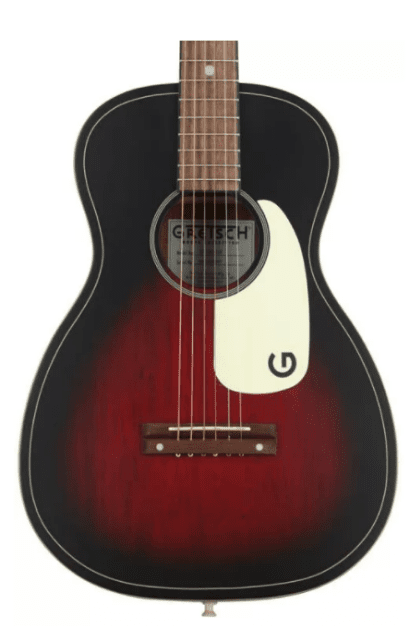
Gretsch G9500 Jim Dandy
Reverb’s #1 selling acoustic guitar in 2021 continues to impress.
This parlor size acoustic is a great option for younger, or smaller framed beginners. Even larger players will appreciate how comfortable and portable it is. It’s nicely made, and offers an old school delta blues vibe that you won’t find anywhere else at this price.
We found ourselves simultaneously surprised, and yet unshocked to learn that the Gretsch G9500 Jim Dandy was the Number 1 selling acoustic guitar on Reverb in 2021. We’ve covered this model before in our best travel guitars review, and we really think it works brilliantly as a beginner instrument as well.
The vintage looks are the most striking thing about the Jim Dandy (full review here). It features all basswood body construction, a tone wood normally found on electric guitars, but in this case, it works really well. It offers similar resonance and warmth to the pine woods used on the vintage guitars that it was inspired by, but is a lot harder-wearing.
The nato neck was very thin, and had a C-shape profile. It was comfortable and we had no issue reaching for chords or even fingerpicking. It had a walnut fingerboard, which we did find felt a little soft, but it should compress over time. There were no sharp fret edges, although the crowns were a little rough.
While it was comfortable to hold and play, because the neck meets the body at the 12th fret rather than the 14th as you’d find on more modern styles, there is less available fretboard, which can limit your playing. This isn’t an issue as a beginner, but it might become a factor as you continue to improve.
Tones are where this guitar really excels. It oozed vintage warmth, and is absolutely perfect if you love the blues. It also had surprising volume and projection for a parlor-size guitar. We found it to be very midrange focused, and that it nicely suited genres other than the blues, too.
Tuning stability was good, although the tuners themselves took some getting used to. They were vintage-style open-gear machines, and unfortunately weren’t the easiest to fine tune with. The action was great right out of the box, which was handy because there is no adjustable truss rod on this model. So neck relief is permanently set.
Verdict: The Gretsch G9500 Jim Dandy is one of the coolest-looking guitars on the market, period. It plays well, sounds good, and the smaller size makes it ideal for everyone from younger players looking for a first guitar to adult beginners who want something comfortable and portable.
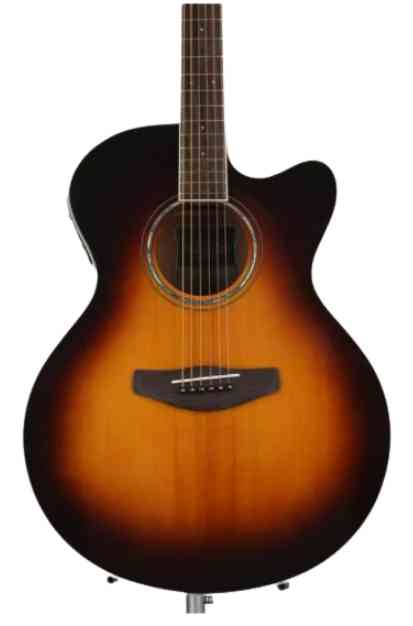
Yamaha CPX600
A stunning guitar with intermediate to professional build quality, priced for beginners.
This guitar offers incredible bang for your buck, with high end woods and hardware used throughout, a beautiful finish and a huge presence. It’s extremely comfortable for a larger instrument, and will serve a player well for a lifetime if it’s looked after.
The Yamaha CPX600 is a medium jumbo guitar, making it a little larger than the FG800 dreadnought we also included in this review. While we found it to be comfortable, the large size might be a limiting factor for younger or smaller players.
It was made with a solid spruce top, with nice grain that peeked through the gorgeous “Old Violin Sunburst” finish. The back and sides were unidentified, and this is largely due to Yamaha’s efforts to improve sustainability. They use a variety of tone woods at different times of year, depending on what is available.
The neck felt extremely similar to the FG800. Slim, comfortable, and fast thanks to the well-applied satin finish. The fretboard was made from rosewood, which is one of our favorite fretboard materials. It was smooth, and felt great under the fingers. As we’ve come to expect from Yamaha, the frets were well finished, with no sprout, no sharp edges or burrs, and nice, smooth crowns.
The tone profile was quite different than anything else we tested in this review. The volume and sustain were incredible, punchy and powerful, with delicate undertones and huge presence. Being an electric-acoustic guitar, we were also pleased to see that it had a piezo pickup system, which accurately reflected the acoustic tones even when amplified.
We were impressed with the tuning stability and, because it had the same die-cast chrome tuners as the FG800, it was easily fine-tuned. On the topic of tuning, the onboard EQ for the pickup system also includes a tuner, which is perfect for beginners to keep their guitar in tune at all times.
Verdict: Country strummers and budding singer songwriters will love the Yamaha CPX600. It offers huge presence, so it won’t get lost in a mix, and this also helps it to stand out as a solo instrument. It has everything a beginner needs and more, including a built-in tuner, great tone, and solid tuning stability.
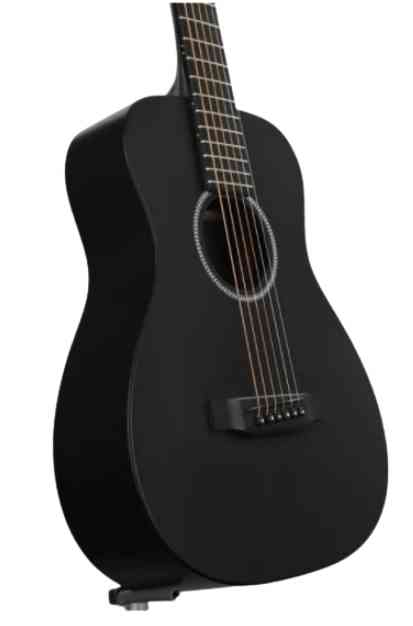
Martin LX Black Little Martin
Johnny Cash vibes and extreme comfort from this reduced size Martin.
Martin is one of the most widely recognized names in guitars, and their Little Martin series has put their legendary tones and quality into the hands of students, amateurs, and pros alike, at a surprisingly affordable price. This model oozes cool, and packs a lot of punch for a smaller guitar.
Martin has been making guitars for close to 200 years, so it’s little wonder they have the brand recognition they enjoy. Of course, such recognition usually means high prices, but that isn’t the case with the Martin LX Black Little Martin.
While unboxing, we were pleased to see that it came in a nice gig bag. Unfortunately, it seems Martin has reduced the quality of the gig bags they ship with their lower-priced guitars. In previous years, they came with a hybrid case, but now it’s a well-padded, albeit simple, backpack-style gig bag.
The construction of the reduced size body is all HPL, which is Martin’s high-pressure laminate. Despite the lack of actual tone woods in use, it still looks great, and it performed brilliantly. The all-laminate construction also makes it incredibly hard wearing and resistant to humidity and temperature, so you really can take it anywhere without worry!
It has a neck made from Stratabond, which is in and of itself an interesting material. It is a specialist plywood with finish impregnated into the material. We absolutely loved the grey/black finish on the neck. The modified Low Oval profile felt good in the hand and it had a fast satin finish.
The Richlite fretboard had a deep ebony color, and felt almost as good. It’s a sustainable man-made alternative and once again improves the durability of the guitar significantly. It had well-finished frets, as you’d expect from any Martin.
In contrast to the dark appearance, this Little Martin was exceptionally bright. It wasn’t particularly loud and the lack of a spruce top did hurt the sustain somewhat, but that doesn’t detract what was otherwise a lovely tonal palette.
Its great tuning stability was helped in large part by the excellent hardware. The Martin-branded sealed-gear tuners had great action and made fine-tuning a breeze.
Verdict: The Martin LX Black Little Martin was definitely one of the coolest-looking guitars on test. This is a short-scale guitar that younger players will find to be exceptionally comfortable. Adult players will find it makes couch practice a lot easier, too. It sounded good and the name on the headstock all but guarantees it will bring years of joy.
How to Choose The Right Guitar For You
When you’re shopping for a beginner’s acoustic guitar, you can buy just a guitar itself, or you can get a kit, which typically includes a case, capo, and other extras (read our favorites here).
Either way, keep the following in mind to make sure you’re getting the features that are most beneficial to you.
Tone Wood
Beginner guitars are all about the fundamentals, which is why you won’t find a lot of exotic woods in use. A solid spruce top with laminate back and sides is a great starting point for a blend of tone and durability.
If you plan to take your guitar everywhere you go, you might want to forego any solid woods in favor of all-laminate construction to avoid damage from temperature and humidity changes
Pickups
If you’d like to plug your acoustic guitar into an amplifier, you’ll need to make sure it has pickups and onboard electronics. These guitars are known as electric-acoustic, or semi-acoustic.
Gig Bag
While not a direct influence on the quality of the instrument it holds, having a gig bag bundled with the guitar will help you keep it in top condition during transport between lessons and home.
Final Thoughts
It’s very easy to get confused when shopping for beginner acoustic guitars. They tend to look very similar and because many manufacturers use similar components, it can be tough to differentiate just by reading the spec sheet. With this in mind, we hope you’ve found this guide to be useful. Read on for a recap of our favorites.
For a great combo of price and great tones, take a look at the Fender CD-60S. If you’re trying to keep costs down, you’ll love the Epiphone Starling. If you’re looking to splash out and treat yourself to the best possible beginner acoustic, we highly recommend the Taylor Academy 10.

Taylor Academy 10
Features: Carved armrest, Sitka spruce top, Ebony fretboard
Benefits: Sparkly tones, Extremely comfortable, Huge sustain

Fender CD-60S
Features: Includes gig bag, Solid spruce top, Low action
Benefits: Great playability, Sparkling top end, Booming voice

Epiphone Starling
Features: Spruce/mahogany construction, Slim neck, Dreadnought body style
Benefits: Rich tones, Handsome looks, Excellent beginner playability

